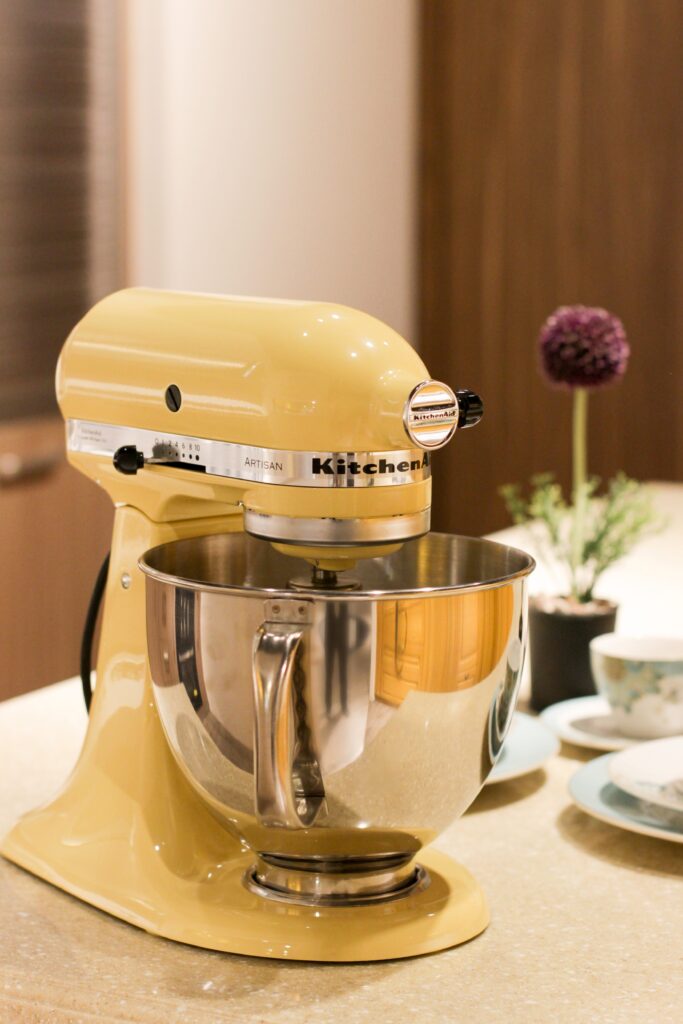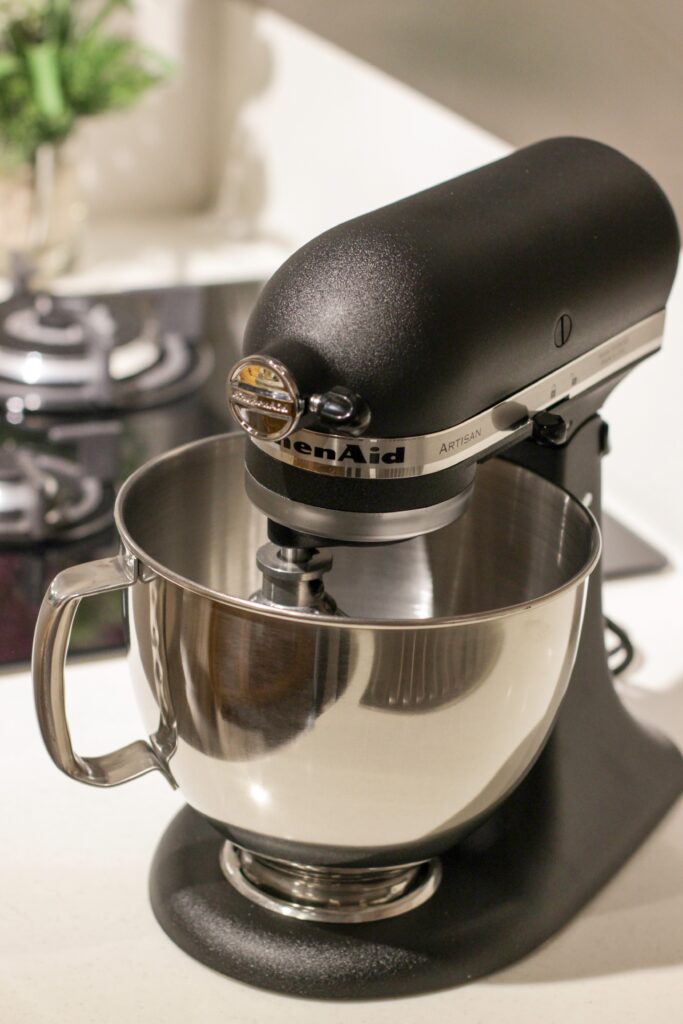As an Amazon Associate, I earn from qualifying purchases.
Introduction
Investing in a KitchenAid Mixer is essential for any passionate home cook. With its professional-level capabilities, it can elevate your cooking experience to new heights. This guide aims to assist you in selecting the best KitchenAid Mixer that suits your needs perfectly.

Understanding KitchenAid Mixers: A Primer
A. The history behind KitchenAid and their legacy in the culinary world
KitchenAid has a rich heritage in the culinary world, dating back to 1919 when they introduced their first stand mixer. Over the years, their commitment to innovation and quality has made them an industry leader, trusted by both home cooks and professional chefs.
B. Different types of KitchenAid Mixers available today
- Stand Mixers: The classic choice for versatile functionality
KitchenAid Stand Mixers are the epitome of versatility. With their robust construction and various attachments, they offer unparalleled performance in tasks such as mixing, kneading, and whipping.
- Hand Mixers: Compact and convenient for smaller tasks
Ideal for tasks that require quick and effortless blending, KitchenAid Hand Mixers are lightweight and portable, making them perfect for smaller recipes or limited kitchen space.
- Mini Stand Mixers: Ideal for limited kitchen space or small batches
For those with limited counter space or those who often prepare smaller batches, the Mini Stand Mixers by KitchenAid provide the same level of performance as their larger counterparts, but in a more compact size.
Key Considerations Before Buying a KitchenAid Mixer

A. Power and Motor Strength
When choosing a KitchenAid Mixer, consider the power and motor strength that aligns with your cooking needs. Higher wattage ensures better performance, especially for heavy doughs and thick batters.
B. Capacity and Bowl Size
The size of the mixer’s bowl determines the quantity of ingredients you can work with at once. Consider your typical batch sizes and choose a KitchenAid Mixer with a bowl size that meets your requirements.
C. Available Attachments and Versatility
KitchenAid Mixers are renowned for their wide range of attachments that expand their functionality. Consider the type of attachments you require:
- Beater Attachments: Choose between flat, flex edge, spiral dough, and other specialized attachments depending on the tasks you perform frequently.
- Whisk Attachments: Balloon and wire whisk attachments are perfect for tasks that require light and airy mixtures.
- Dough Hook Attachments: Essential for bread and pizza dough preparation, these attachments knead the dough to perfection.
- Other Attachments: Explore options such as pasta rollers, ice cream makers, and more to enhance your culinary repertoire.
D. Design and Aesthetics

Kitchen appliances are not just tools; they should also complement your kitchen aesthetics. KitchenAid offers a wide range of mixer designs, from classic to contemporary, allowing you to find the perfect style that matches your kitchen decor.
E. Noise Level and Quieter Models
Consider the noise level of different KitchenAid models. Some mixers come with noise reduction features, ensuring a quieter operation that won’t disturb your kitchen ambiance.
F. Cleaning and Maintenance
Taking care of your KitchenAid Mixer is essential for its longevity. Consider the ease of cleaning and maintenance when choosing your ideal model.
Top KitchenAid Mixer Models: A Comparative Analysis
To help you make an informed decision, let’s compare some of the top KitchenAid Mixer models available:
A. KitchenAid Artisan Series Stand Mixer
- Features and Specifications
- Powerful motor with 325 watts of power
- 5-quart stainless steel mixing bowl
- Comes with a flat beater, wire whip, and dough hook attachments
- Available in various colors to suit your style
- Pros and Cons
Pros:
- Versatile functionality for a wide range of cooking tasks
- Durable construction ensures long-lasting performance
- Large capacity bowl for preparing bigger batches
Cons:
- Higher price point compared to other models
- Relatively heavier and bulkier design
B. KitchenAid Professional 600 Series Stand Mixer
- Features and Specifications
- Robust 575-watt motor for heavy-duty tasks
- 6-quart stainless steel mixing bowl with a comfortable handle
- Comes with a flat beater, wire whip, and PowerKnead spiral dough hook attachments
- 10-speed settings allow precise control over mixing
- Pros and Cons
Pros:
- Exceptional power and capacity for demanding recipes
- Solid construction ensures stability and durability
- Suitable for large families or frequent entertainers
Cons:
- Higher price point, making it an investment for serious home cooks
- Bulkier design may require additional storage space
C. KitchenAid Classic Plus Series Mixer
- Features and Specifications
- 275-watt motor for everyday tasks
- 4.5-quart stainless steel mixing bowl
- Includes a flat beater, wire whip, and dough hook attachments
- Offers 10-speed options for various mixing requirements
- Pros and Cons
Pros:
- More affordable option without sacrificing performance
- Compact design suitable for smaller kitchens
- Ideal for beginner and intermediate home cooks
Cons:
- Smaller capacity compared to other models
- May not handle heavy dough or large batches as efficiently
D. Other notable models worth considering
Explore other models, such as the KitchenAid Professional 5 Plus Series, KitchenAid Pro Line Series, or KitchenAid Architect Series, for additional features and functionalities that may suit your cooking needs.
Selecting the Right KitchenAid Mixer for Your Cooking Needs

Consider your cooking preferences and level of expertise to find the perfect KitchenAid Mixer:
A. Beginner Home Cooks
For those starting their culinary journey, finding a mixer that offers a balance of functionality and budget is essential. Models like the KitchenAid Classic Plus Series provide adequate power and versatility without overwhelming features.
B. Baking Enthusiasts
Bakers rely heavily on precise mixing and kneading. Look for mixers with higher power and larger bowl capacities, such as the KitchenAid Professional 600 Series, for optimal dough preparation and versatility.
C. Advanced Home Cooks
Advanced home cooks who regularly handle complex recipes and larger batches require a mixer with higher power and capacity. The KitchenAid Pro Line Series or the KitchenAid Architect Series are excellent options for their enhanced performance and durability.
D. Specialty Users
If you have specific dietary preferences, such as gluten-free or vegan cooking, explore mixers that offer specialized attachments for these needs. KitchenAid offers options like the KitchenAid Gluten-Free Spiralizer Attachment and the KitchenAid Vegetable Sheet Cutter Attachment.
Where to Purchase Your KitchenAid Mixer
Consider these options for purchasing your KitchenAid Mixer:
A. Authorized Retailers
Visit authorized retailers, such as kitchenware stores or appliance outlets, to personally explore the mixers and seek expert advice.
B. Online Platforms
Explore different online stores like Amazon, Williams Sonoma, or Bed Bath & Beyond. Compare prices, read customer reviews, and take advantage of convenient delivery options.
C. Secondhand Market Considerations
If budget is a significant factor, consider purchasing a used KitchenAid Mixer from reliable sources like online marketplace platforms or local classified ads. Ensure the mixer is in good working condition before making the purchase.
Tips and Tricks to Master Your KitchenAid Mixer
To make the most of your KitchenAid Mixer, follow these tips and tricks:
A. Proper Usage Techniques and Safety Precautions
Read the user manual thoroughly to understand your mixer’s capabilities and proper usage techniques. Follow all recommended safety precautions to prevent accidents or damage to the appliance.
B. Getting to Know Your Mixer’s Settings and Controls
Become familiar with the various speed settings and mixing techniques your KitchenAid Mixer offers. Experiment with different attachments and explore the full potential of your mixer.
C. Maintenance and Care for Longevity
Regularly clean your mixer attachments and bowls according to the manufacturer’s instructions. Take care not to overload the mixer beyond its capacity to prevent strain on the motor.
D. Troubleshooting: Common Issues and How to Solve Them
If you encounter common issues such as mixer vibrations, uneven mixing, or strange noises, refer to the troubleshooting section of the user manual or consult the manufacturer’s website for advice.
Conclusion
Choosing the right KitchenAid Mixer is crucial to elevate your cooking experience. By considering your specific needs, budget, and preferences, you can make a well-informed decision that will enhance your culinary endeavors for years to come.
Frequently Asked Questions (FAQs)
A. What is the difference between tilt-head and bowl-lift models?
Tilt-head models allow easy access to the mixing bowl by tilting the head backward, while bowl-lift models use a lever to raise and lower the bowl. The choice depends on personal preference and available space in your kitchen.
B. How do I choose the right size of KitchenAid Mixer?
Consider the types of recipes you frequently prepare and the number of people you usually cook for. Smaller models with a 4.5-quart bowl are suitable for smaller batches, while larger 6-quart bowls accommodate more significant quantities.
C. Are third-party attachments compatible with KitchenAid Mixers?
While KitchenAid offers a wide range of official attachments designed specifically for their mixers, some third-party attachments may be compatible. However, it’s important to check compatibility and quality before purchasing.
D. Is a higher wattage always better for a mixer?
Higher wattage generally indicates a more powerful motor, allowing the mixer to handle heavier tasks more efficiently. However, for basic recipes, a lower-wattage mixer may suffice. Consider your specific needs before choosing the wattage.
E. How long can I expect a KitchenAid Mixer to last with regular use?
With proper care and maintenance, a KitchenAid Mixer can last for several years or even decades. The durability and longevity of these mixers are renowned, making them a worthwhile investment.
F. Can I purchase additional attachments separately?
Yes, KitchenAid offers a wide selection of additional attachments that can be purchased separately. These attachments allow you to expand your mixer’s versatility and explore new culinary techniques.
As an Amazon Associate, I earn from qualifying purchases.


